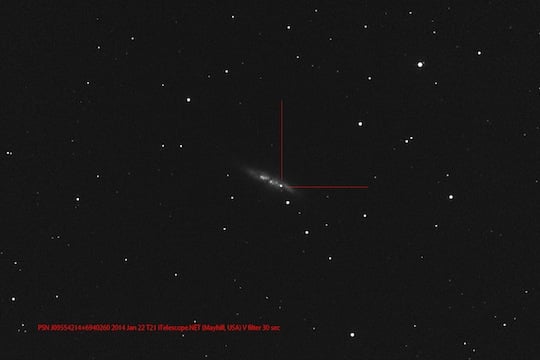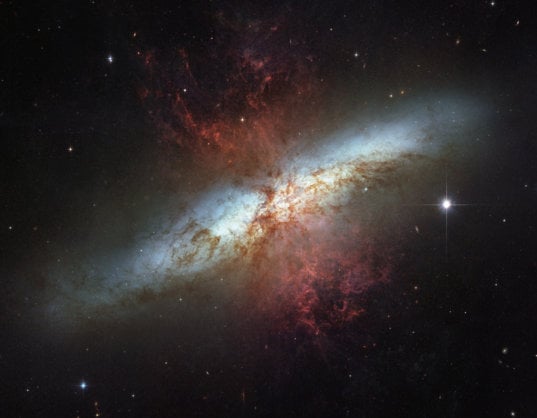This article is more than 1 year old
Amateurs find the 'HOLY GRAIL' supernova – right on our doorstep
Exploding star a mere 11.5 million light-years away and it's a boon for science
Pics Exploding stars aren't an uncommon event in a universe with billions upon billions of stars in billions upon billions of galaxies – but catching an explosion in the act on our galactic doorstep is rare.
(Well, 11.5 million light years away is, in astronomical terms, quite close by, and as I'll explain later, the type and proximity of this supernova makes it something of a Holy Grail for astronomy.)
Dr Brad Tucker at the Australian National University helped The Register work through the timeline of the discovery. He said the first announcement of the discovery was made by Russian amateur astronomers using the MASTER-Amur robotic telescope in Blagoveshchensk; their telegram read:
D. Denisenko, V. Lipunov and E. Gorbovskoy also report: we have checked the latest MASTER images of [the galaxy] M82 before the supernova explosion. The object was not present on MASTER-Kislovodsk triplets of unfiltered 60-sec exposures on 2014 Jan. 03.77-03.81 UT (combined limiting magnitude 19.6) and on MASTER-Amur triplets on 2014 Jan. 13.56-13.59 UT (combined m_lim=18.5). Stacked MASTER images of Jan. 03 and Jan. 13 are uploaded to http://master.sai.msu.ru/static/OT/M82-2014Jan03-13-MASTER.jpg
This has sent other astronomers scrambling to find earlier images from their own telescopes (for example, students working with Steve Fossey at University College, London, have found an earlier grab), but the Russian group was the first to announce the discovery of the object.
The first confirmation images were taken by Seiichiro Kiyota, who was remotely operating the Mayhill telescope as part of the iTelescope project hosted by New Mexico Skies, caught the stunning image below of an explosion in galaxy M82.

The M82 supernova. Image: Seiichiro Kiyota (Kamagaya, Japan)
Other astronomers quickly moved to confirm the observations, with the history of the discovery as it now stands documented here.
According to Dr Tucker, exploding stars are very common in the universe - about 50 happen per second, according to estimates – but nearby ones are rarely caught “in the act”. As he Tweeted:
Exploding stars are common, nearly 50 stars blow up every second! However, the vastness of the Universe means they are rarely close to us.
— Brad Tucker (@btucker22) January 22, 2014
Nearby supernovae are exciting because a lot more cosmic stuff might arrive at Earth for study:
The supernova in M82 is so close, there is a slim chance we may be able to detect neutrinos, very high energy particles, from the explosion
— Brad Tucker (@btucker22) January 22, 2014
Dr Tucker explained to The Register that the object was first confirmed as a supernova by analysis of its spectrum at Apache Point's ARC 3.5 in New Mexico.
The timing of the observations is what sent astronomers to Twitter and to their telescopes, Tucker explained: “Any supernova that we catch early will help us understand how they explode and what the star is that explodes, as the earlier we can observe a supernova, the more clues we get. For instance, at very early times, between an hour and a couple days, we may be able to see the shockwave of the explosion propagate through the star, much like the shockwave from a nuclear bomb occurs before the nastiness follows.”
This supernova has been classified as a Type 1a, he went on, which is the type that's used to measure distances in the universe. It was observations of 1a supernovae that led Brian Schmidt to his 2011 Nobel prize-winning conclusion that the expansion of the universe is accelerating.
“The fact that this SN is a type Ia, caught young, means we have a good chance of finding clues to the explosion. Since it is so close, the Hubble Space Telescope has pre-imaging of the galaxy, images longer before the star would have blown up, which may allow us to directly see the star. It is so close, we can use actual measurements (i.e. velocity) instead of redshift,” said Dr Tucker.
“The only closer supernova was SN 1987A which went off in the Large Magellanic Cloud,” he added to The Register.

A Hubble shot of M82, with no supernova. Image: ASA, ESA, and The Hubble Heritage Team
Even better, Dr Tucker said, the supernova's surroundings make it instantly valuable to astrophysics: “It is a 'reddened' Ia - meaning it occurs in a known dusty environment. By knowing there is lots of dust, we can analyze how the dust is impacting the colors of the supernova, and therefore the distance measurements, and use this to calibrate other supernovae. In short, this is the Holy Grail.”
He said the new supernova ticks off nearly everything astronomers could want if they had a wish-list.
Early hopes that neutrinos from the new explosion might be detectable from Earth, however, appear to have been dashed because of the dusty environment of the explosion.
Amateurs all over the world are now being encouraged to check any images they may have of M82 taken in the past week. ®
Bootnote
The question of who “discovered” the object is contentious. While The Register has left our original text in place, students at University College, London supervised by Steve Fossey are also credited with first spotting the supernova. If this is so, then our apologies to the London group.
It is, of course, possible or even likely that earlier images of the supernova exist, but haven't yet been identified by their owners. ®
